Japanese astilba: description and cultivation

Japanese astilba is considered the most beautifully flowering plant. It is unpretentious in cultivation and care, therefore it is very popular among gardeners, who use it for landscape design in suburban areas. This shrub also tolerates severe frosts. To grow a healthy plant at home, the characteristics of each variety should be taken into account.
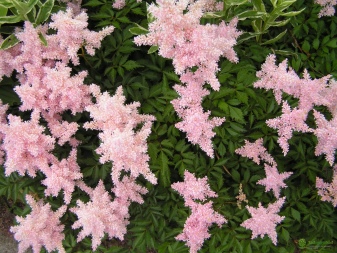

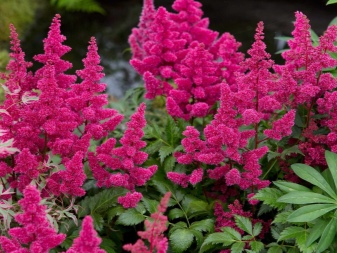
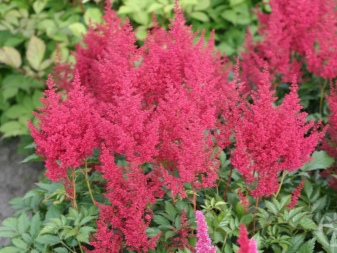
Description
Japanese Astilba is a perennial herb that belongs to the Saxifrage family. Today, there are more than 200 varieties of this shrub, each of which is characterized by its own color, splendor of flowering, structure and growth. Herbaceous plants of this type are intended for open ground, since their height can reach 80 cm, which does not allow them to be grown indoors. Japanese astilbe is distinguished by small but dense leaves that have pronounced patterns. Unlike other types of astilbe, in Japanese during flowering, a few buds of a pink or snow-white shade appear, which, even after complete drying, do not lose their shape and continue to decorate the garden plot.
The flowering period for the plant usually begins in June and lasts until September. At this time, flowers are formed on the bushes, formed into panicles from 10 to 50 cm long. They have a delicate aroma, similar to bird cherry.
After flowering, the fruits ripen, boxes with small seeds inside appear in place of flowers. Japanese astilbees of lilac and red shades look especially beautiful in landscape design, they are originally complemented by dark zilon openwork foliage.
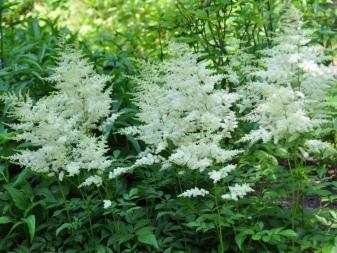
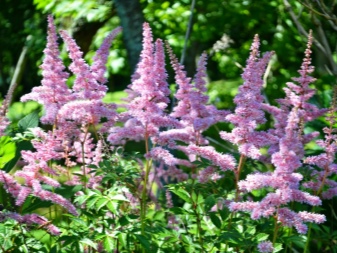
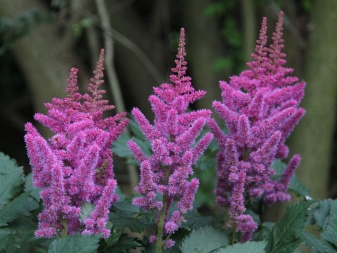
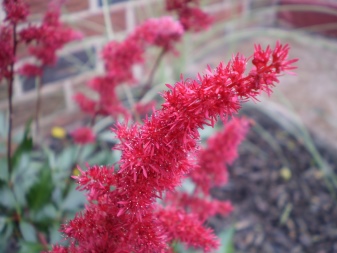
With the onset of cold weather, the ground part of the shrub dies off, the root system is strengthened for wintering and with the arrival of spring is ready to give new offspring. Every spring, buds develop on the upper part of the roots, which are capable of giving an increase per season from 3 to 5 cm, while the rhizomes themselves in the lower part die off over time.
To ensure the normal development of the flower and the formation of new buds, immediately after dying off, the ground part is cleaned and the site of the landing pit is covered with a soil substrate. Astilba Japanese, as a rule, is planted in flower beds with Siberian iris and fern. This allows you to create original compositions in landscape design. The shrub goes well with paniculate bells and phlox.
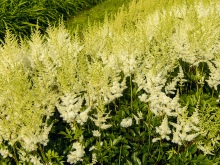


Hybrid varieties
Thanks to the efforts of breeders, many hybrid varieties of Japanese Astilba have been bred, which are characterized by a snow-white color and are ideal for growing outdoors. On their basis, varieties were created, the inflorescences of which are striking in their diverse colors. The most popular hybrids of Japanese astilba include the following.
- Montgomery. It is a perennial spreading bush, the height of which can be from 50 to 80 cm.The leaves of the plant are glossy, feathery, they are painted in a reddish-brown tone and have a length of up to 40 cm.During flowering on the bushes (from May to August), diamond-shaped inflorescences 10 mm in diameter, their length is 17 cm. Inflorescences are formed from small fragrant flowers, their color can be either red-brown or dark red. The petals are narrowed at the tops.


- Mainz. This is one of the most beautiful varieties of the Japanese Astilba hybrid, in which purple-pink flowers gather in paniculate, dense and fluffy inflorescences up to 30 cm long. The plant is perennial, prefers to grow in the garden in partial shade places. The height of this astilbe ranges from 50 to 70 cm, the flowering period is from June to July. The bush perfectly tolerates wintering without shelter, since it can withstand frost down to -34 C.
This variety practically does not get sick, does not need a garter and is ideal for group planting on the banks of reservoirs and in mixborders.
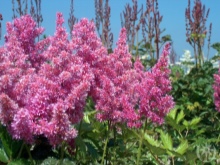

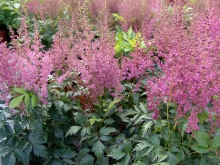
- Red Sentinel... This is an undemanding variety that can grow in one place for many years without losing its decorative effect. The height of the plant usually reaches 90 cm, maybe more if the soil is fertilized and watered in a timely manner. The flower prefers to grow in well-drained, moist soil, in shaded areas. If you plant astilbe in an area illuminated by a bright sun, then it will grow well, but it will begin to bloom weaker. The flowering period for Red Sentinel occurs from June to August, during which the plant is covered with carmine-red small flowers, collected in inflorescences up to 40 cm long. They have an average density and have a diamond shape. The leaves of the plant are dark green, feathery. The bushes are resistant to severe frosts and are recommended for planting in flower beds, lawns.
The plantings of astilba are beautifully combined with iris, host, bells and fern.
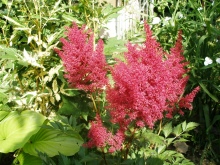
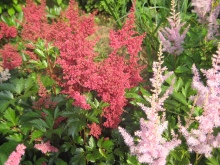
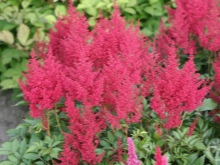
- Peach Blossom. This variety is one of the most common. The bushes grow up to 80 cm in height and up to 70 cm in width. The leaves of the plant are green, at the edges they are painted in a brown shade. This hybrid begins to bloom in July and has a short flowering duration of only 15 days. Flowers can be either pale lilac or pink. They form paniculate inflorescences from 10 to 15 cm long; after flowering, fruits appear on the bushes in the form of boxes with seeds.
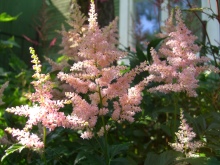

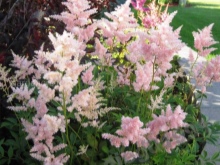
- "Europe"... Similar to the previous varieties of hybrids, this Japanese astilba is a herbaceous perennial with a cushion-shaped crown, the height of which, with proper care, can reach 40 cm. The leaves of the plant are dissected, painted in bright green. Astilba blooms from July to August, forming pale pink rhombic inflorescences of medium density. The plant loves moisture very much, it can be grown both in areas well-lit by the sun and in the shade. Suitable for group planting in curbs and for cutting.
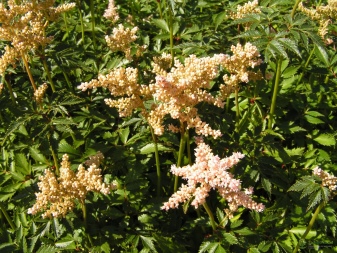
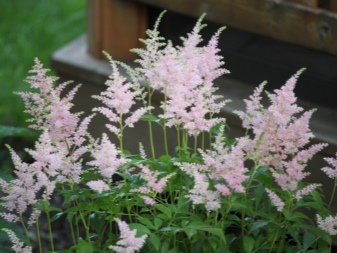
- "Bow et mi". This is a relatively new variety that appeared in Russia quite recently. It is distinguished by pinkish inflorescences of an unusual shape, glossy foliage, painted in a dark green tint, and a red stem. The bush is compact, even, during flowering it is abundantly covered with large flowers. Recommended for disembarkation near fountains and reservoirs, where the level of humidity is high.

- Bonn. It is characterized by inflorescences of pink or dark carmine color. The bush prefers to grow in areas with loose, nutritious soil, where it can reach a length of 70 cm. The illumination on the site should be moderate, the plant does not tolerate the scorching rays of the sun in hot weather, therefore it is recommended to plant it near water bodies. This astilba is distinguished by very beautiful cone-shaped inflorescences. They appear on the bushes in July and look original against the background of green foliage.
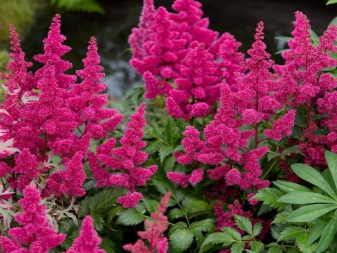
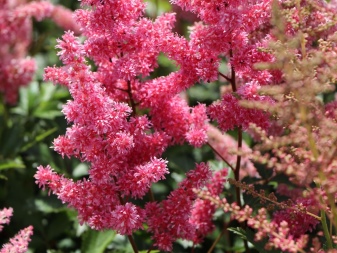
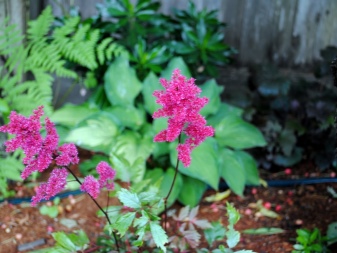
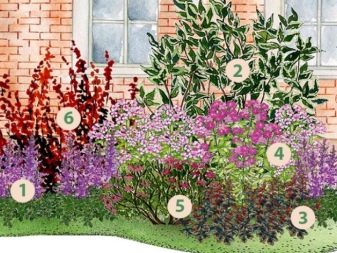
Landing
Unlike other varieties of astilba, Japanese is not very demanding on the timing of planting, so it can be planted throughout the growing season, even during flowering. Experienced gardeners prefer planting. in Maywhen the soil has warmed up well and replenished with moisture reserves. Before planting a plant, you must carefully prepare the site and water it abundantly. It is best to choose shady places. This will help preserve the brightness in the color of the flowers.
When planting in groups between seedlings, a distance of 50 cm should be observed. In areas with poor soil, it will not hurt to pre-apply a complex consisting of mineral fertilizers to feed the root system. The size of the planting hole is determined for each seedling individually, depending on the size of the roots.
The seedling must be placed in the hole so that the growing point is above the soil level. The soil in the hole is abundantly moistened, and after planting the plants around the bush, mulching with peat chips is performed, it will protect the roots from drying out.



Care
Regardless of which variety of Japanese astilba is planted, it needs attention and proper care at first. If the leaves on the bushes begin to turn yellow, then this indicates that the plant does not have enough lighting, then it will have to be transplanted to a new place. Intense heat and insufficient watering will cause the astilbe to wilt. To save the bush from this, you should carry out regular watering and shade the plant with a net.
In addition, you need to constantly monitor that the level of acidity of the soil on the site is optimal. To do this, dolomite flour should be periodically added to the soil, which will prevent it from souring. Clearing the area from weeds is considered no less important in the care, this must be done carefully so as not to damage the roots lying high.
Loosening is best done to a depth of 2-3 cm. As for fertilization, Japanese astilbe should be fed 3 times per season, they do it in spring, summer and late autumn.
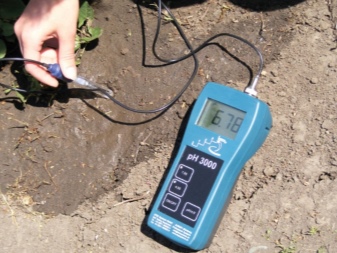
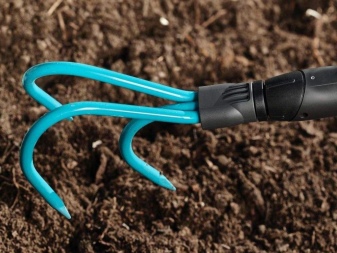
Diseases and pests
Despite the fact that Japanese Astilba varieties are highly immune to diseases, with improper care, they can still be exposed to diseases and the invasion of the following pests.
- Strawberry nematode. It can be quickly noticed by the appearance of brown spots on the foliage, since the insect settles on the leaf plates and feeds on their sap. If you do not take any measures in a timely manner, then the bush will begin to slow down in growth, wither and die.
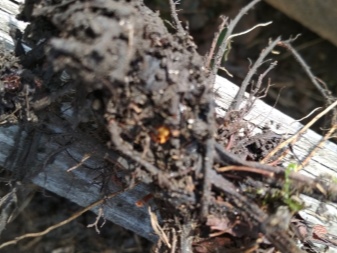

- Pennitsa. This is a flying pest that leaves foamy saliva with larvae deposited in it on plant leaves. After that, astilbe begins to lose its decorative effect, since its leaves are covered with yellow spots and wrinkled. To save the bush from death will help the processing of foliage "Confidor" and "Karbofos".
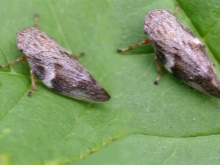
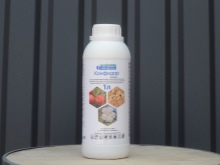

- Gall nematode. Usually it settles on the rhizomes of the plant, this insect can be noticed only in the second year, when the astilbe slows down in its growth and stops blooming. To cure a flower, you should carefully examine its roots and remove those that have a lesion. Healthy areas of rhizomes should be treated with Fitoverm.
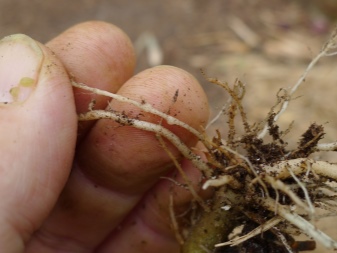
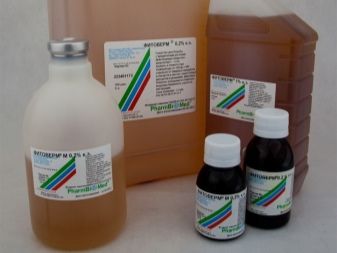
As for diseases, they do not exist, except that the bush from lack of moisture and strong lighting can turn yellow and dry. To solve this problem, a transplant is performed to a new place.
Examples in landscape design
Hybrid varieties of Japanese astilba are widely used in the design of parks and gardens. This beautiful plant can be used to decorate both simple flower borders and complex compositions. Astilbe with ornamental shrubs and ferns look especially gorgeous. They are ideal for decorating pools, ponds, for this they are recommended to be combined with thuja, juniper and cypress trees. To decorate suburban areas, Japanese astilba, mountain goat, tulips, lilies of the valley and irises are planted on flower beds at the same time.
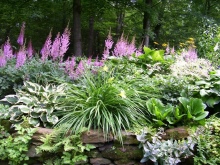
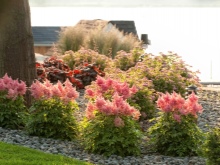
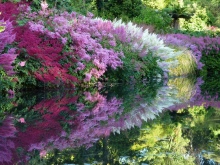
How to grow astilba, see below.







































































































The comment was sent successfully.